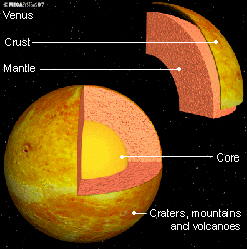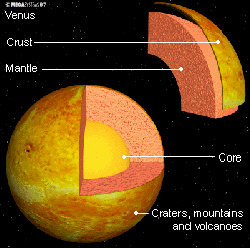|
|
|
VENUS
Venus / Introduction
The second planet of our Solar System was named after the Roman goddess of
love. For centuries, people were convinced that there could be life on Venus
as the planet is similar to the earth as regards mass and density of matter.
 Its
mass is 81.5 % of the mass of the earth, and its mean density is 5.25 g/cm3.
With a diameter of 12,150 kilometers, the planet is only slightly smaller
than our earth. Its
mass is 81.5 % of the mass of the earth, and its mean density is 5.25 g/cm3.
With a diameter of 12,150 kilometers, the planet is only slightly smaller
than our earth.
Venus also features an atmosphere with thick layers of cloud. The conditions
onthe planet are nevertheless not at all suitable to support life.
Below the thick cover of cloud, the temperature is uniform and of more than
450 °C.The planet and its atmosphere are heated up by the sun, but the thick
clouds prevent the heat from radiating. The density of the atmosphere
results in a high pressure on the surface of the planet comparable to the
pressure of water at 1000 meters below sea level on the earth. The
atmosphere consists of 95% carbon dioxide.
Venus completes a full orbit around the sun in 225 days. Its mean distance
to the sun is 108 million kilometers.
Orbit of Venus
The orbit of Venus around the sun is located inside the orbit of the earth
and the planet is therefore part of the ”inner planets“. Its orbit period is
224.7 days.
 In
its orbit around the sun, the planet is sometimes located between the earth
and the sun. We can therefore observe Venusin different phases,similar to
those of the moon and of Mercury (i.e. new Venus and full Venus). In
its orbit around the sun, the planet is sometimes located between the earth
and the sun. We can therefore observe Venusin different phases,similar to
those of the moon and of Mercury (i.e. new Venus and full Venus).
Venus rotates around its own axisin the direction opposite to its orbit
(retrograde rotation) and the planet has an extremely low rotation velocity.
A Venus day therefore is longer than a Venus year. In other words,
Venusorbits the sun faster than it rotates aroundits own axis. One Venus day
equals 243 days on earth. The rotation axis of the planet is inclined by 2.7
degrees from the vertical of its orbit plane. The inclination of the axis of
the earth is 23.5 degrees and therefore much more prominent.
Venus Atmosphere
The planet Venus is completely shrouded in thick clouds. The upper layers of
this cloud cover rotate around the planet once every four days.
The atmosphere consists mainly of carbon dioxide (95%). It even rains
sometimes on this hostile planet. The rain here though consists of sulphuric
acid. As the temperatures on Venus are very high, these raindrops do not
reach the surface as they evaporate in the atmosphere. Despite these
appalling conditions, spacecraft where able to land on Venus and to take
pictures of its dusty surface.
The average temperature on Venus is above 450 °C. This is sufficient to melt
lead. The temperature on the planet is very uniform throughout and the poles
are only marginally cooler. What we observe on Venus could best be described
as a gigantic greenhouse effect which turns Venus into the hottest planet in
our Solar System.
While the sun heats up the surface of Venus, its thick atmosphere with its
huge layers of haze preserve the heat. Compared to the earth, the pressure
on the surface of Venus is 100 times greater. The upper cloud layers rotate
relatively fast around the planet while thelayers near the surface show
virtually no turbulence. These winds of only a few kilometers per hour cause
no serious erosion and the surface of the planet therefore undergoes only
minimal changes.
Venus Surface
The surface of Venus resembles a hot desert with large plains and a few
mountains and valleys.
 The
largest highland area is called Aphrodite Terra. It is located near
theequator and has the size of Africa. The
largest highland area is called Aphrodite Terra. It is located near
theequator and has the size of Africa.
Generally, Venus features less mountains than the earth. Only 10 % of its
surface is covered by highlands, although some of the mountains are as high
as 11,000 meters (Maxwell Montes). Seventy percent of the surface is taken
up by large plains and twenty percent by low lands. The crust of Venus shows
many similarities with the crust of the earth, but in contrast to the earth,
it consists of only one single plate. In its interior, Venus is made up of a
liquid core of iron and nickel, surrounded by a mantle and a thin
crust.There is evidence of volcanic activity a few hundred million years ago
and scientists are not sure whether there are still active volcanoes to be
found on Venus. However, cold lava streams longer than any river on the
earth were observed on the planet’s surface.
Craters are also a feature of the surface of Venus, although they are not as
numerous as on Mercury. Impact by celestial objects is prevented by the
thick atmosphere of the planet and only larger rocks reach its surface,
leaving impact craters behind. Due to the very low level of erosion, most of
these craters are fully intact.
Venus Phases
Venus is one of the inner planets. Its orbit is located between the sun and
the orbit of the earth. Similar to the moon, Venus appears in different
phases.
Venus is particularly easy to observe during its first and last quarters. At
the time of an upper or lower conjunction, Venus is not visible from the
earth. The term conjunction describes the situation where several celestial
bodies are located on the same longitude.
At a lower conjunction, (sequence earth-Venus-sun), Venusis closest to the
earth. However, we cannot see the planet as we only see its dark side.From
that point, Venus is in its first quarter until it finally reaches the other
extreme in the upper conjunction. When the planet is positioned to the right
of the sun, i.e. in its first quarter, it appears to us as the morning star.
Venus in the last quarter is our evening star.
The greater the angular distance (called the elongation) of Venus to the sun,
the better it is visible from the earth. The maximum elongation is 48
degrees while the maximum elongation of Mercury is only 28 degrees. As a
consequence, Venus is visible for a considerable time after sunset and
before sunrise, while Mercury is in the sky for much shorter periods.
©by megasystems
|
|
|